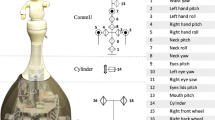Abstract
The purpose of this study is to develop a game system that uses biofeedback to provide an attractive entertaining game. In general, negative biofeedback is used for relaxing users; however, in our game system positive biofeedback is used for arousing them. We assumed that the latter biofeedback method could affect the users’ emotional states effectively; that is why we call it positive biofeedback. We used skin conductance response (SCR) as a biofeedback signal in our game system because SCR can effectively reflect the mental agitation of users. Therefore, we developed a teddy bear robot to be the motion media for providing feeding back the measured SCR information to users. When the value user SCR increases during interaction with this robot, the robot starts moving its arms and head in relation to the transition of SCR values so that it appears to be agitated. We then conducted two experiments to measure the participants’ SCR transitions. From the results of these experiments, we can state that the users’ emotional attachment to the robot and the robot’s behaviors in reaction to user biological signals are important cues that create positive biofeedback.
Preview
Unable to display preview. Download preview PDF.
Similar content being viewed by others
References
Sakurazawa, S., Munekata, N., Yoshida, N., Tsukahara, Y., Matsubara, H.: Entertainment Feature of the Computer Game Using a Skin Conductance Response. In: Proceedings of ACM SIGCHI International Conference on Advances in Computer Entertainment Technology ACE 2004, pp. 181–186 (2004)
Sakurazawa, S., Munekata, N., Yoshida, N., Tsukahara, Y., Matsubara, H.: Entertainment feature of a computer game using a biological signal to realize a battle with oneself. In: Rauterberg, M. (ed.) ICEC 2004. LNCS, vol. 3166, pp. 345–350. Springer, Heidelberg (2004)
Munekata, N., Yoshida, Y., Sakurazawa, S., Tsukahara, Y., Matsubara, H.: The effect of biofeedback in the game using biological signal (in Japanese). Japan Society for Fuzzy Theory and Intelligent Informatics 17(2), 243–249 (2005)
Sekiguchi, D., Inami, M., Tachi, S.: RobotPHONE:RUI for Interpersonal Communication. In: Proceedings of CHI 2001 Extended Abstracts, pp. 277–278 (2001)
Geddes, L.A.: History of the Polygraph, an Instrument for the Detection of Deception. Bio-med. Eng. 8, 154–156 (1973)
Dawson, M.E., Schell, A.M., Filion, D.L.: The electrodermal system. In: Cacioppo, J.T., Tassinary, L.G., Berntson, G.G. (eds.) Handbook of Psychophysiology, 2nd edn., pp. 200–223. Cambridge University Press, New York (2000)
Ohman, A., Soares, J.J.F.: Unconscious anxiety, phobic responses to masked stimuli. Journal of Abnormal Psychology 103, 231–240 (1994)
Gross, J.J., Levenson, R.W.: Emotional suppression, self-report and expressive behavior. Journal of Personality and Social Psychology 64, 970–986 (1993)
Gross, J.J., Levenson, R.W.: Hiding feeling, the acute effects of inhibiting negative and positive emotion. Journal of Abnormal Psychology 106, 95–103 (1997)
Petrie, K.J., Booth, R.J., Pennebaker, J.W.: The Immunological Effects of Thought Suppression. Journal of Personality and Social Psychology 75, 1264–1272 (1998)
Author information
Authors and Affiliations
Editor information
Editors and Affiliations
Rights and permissions
Copyright information
© 2006 IFIP International Federation for Information Processing
About this paper
Cite this paper
Munekata, N., Yoshida, N., Sakurazawa, S., Tsukahara, Y., Matsubara, H. (2006). Design of Positive Biofeedback Using a Robot’s Behaviors as Motion Media. In: Harper, R., Rauterberg, M., Combetto, M. (eds) Entertainment Computing - ICEC 2006. ICEC 2006. Lecture Notes in Computer Science, vol 4161. Springer, Berlin, Heidelberg. https://doi.org/10.1007/11872320_46
Download citation
DOI: https://doi.org/10.1007/11872320_46
Publisher Name: Springer, Berlin, Heidelberg
Print ISBN: 978-3-540-45259-1
Online ISBN: 978-3-540-45261-4
eBook Packages: Computer ScienceComputer Science (R0)




